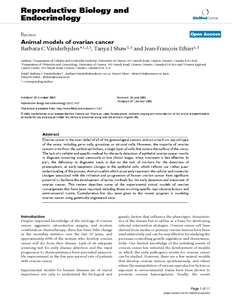Vanderhyden, BC; Shaw, TJ; Ethier, JF
(2003)
Animal models of ovarian cancer.
Reproductive Biology and Endocrinology, 1 (67).
ISSN 1477-7827
https://doi.org/10.1186/1477-7827-1-67
SGUL Authors: Shaw, Tanya J
![[img]](https://openaccess.sgul.ac.uk/534/1.hassmallThumbnailVersion/1477-7827-1-67.pdf)  Preview |
|
["document_typename_application/pdf; charset=binary" not defined]
Published Version
Download (587kB)
| Preview
|
Abstract
Ovarian cancer is the most lethal of all of the gynecological cancers and can arise from any cell type of the ovary, including germ cells, granulosa or stromal cells. However, the majority of ovarian cancers arise from the surface epithelium, a single layer of cells that covers the surface of the ovary. The lack of a reliable and specific method for the early detection of epithelial ovarian cancer results in diagnosis occurring most commonly at late clinical stages, when treatment is less effective. In part, the deficiency in diagnostic tools is due to the lack of markers for the detection of preneoplastic or early neoplastic changes in the epithelial cells, which reflects our rather poor understanding of this process. Animal models which accurately represent the cellular and molecular changes associated with the initiation and progression of human ovarian cancer have significant potential to facilitate the development of better methods for the early detection and treatment of ovarian cancer. This review describes some of the experimental animal models of ovarian tumorigenesis that have been reported, including those involving specific reproductive factors and environmental toxins. Consideration has also been given to the recent progress in modeling ovarian cancer using genetically engineered mice.
| Item Type: |
Article
|
| Additional Information: |
© 2003 Vanderhyden et al; licensee BioMed Central Ltd. This is an Open Access article: verbatim copying and redistribution of this article are permitted in all media for any purpose, provided this notice is preserved along with the article's original URL. |
| Keywords: |
Animals, Animals, Genetically Modified, Carcinogens, Environmental, Cell Line, Tumor, Cell Transformation, Neoplastic, Chickens, Epithelial Cells, Female, Hormones, Humans, Mice, Mice, Inbred C3H, Models, Animal, Neoplasm Transplantation, Neoplasms, Experimental, Ovarian Neoplasms, Ovulation, Rabbits, Rats, Rats, Sprague-Dawley, Rats, Wistar, Sheep, Species Specificity, Xenograft Model Antitumor Assays |
| Journal or Publication Title: |
Reproductive Biology and Endocrinology |
| ISSN: |
1477-7827 |
| Dates: |
| Date | Event |
|---|
| 7 October 2003 | Published |
|
| PubMed ID: |
14613552 |
| Web of Science ID: |
14613552 |
  |
Download EPMC Full text (PDF)
|
 |
Download EPMC Full text (HTML)
|
 |
Go to PubMed abstract |
| URI: |
https://openaccess.sgul.ac.uk/id/eprint/534 |
| Publisher's version: |
https://doi.org/10.1186/1477-7827-1-67 |
Statistics
Item downloaded times since 07 Oct 2014.
Actions (login required)
 |
Edit Item |




